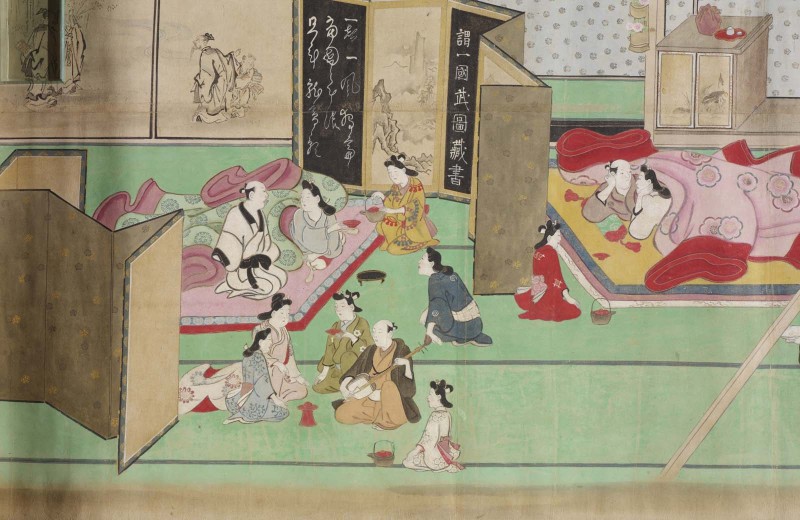It depicts a day in the life of the Yoshiwara, and Allen walked its length with me, starting at the right end, talking first about a section showing travelers bound for the district.
“This opening scene introduces you to some of the cast of characters," Allen says. "For instance, there is a samurai in disguise. He’s incognito, wearing a straw hat to cover his features. Samurai were not officially allowed to enter the Yoshiwara, so they hid their faces under these straw hats.
“To his right,” Allen continues, “there is a Buddhist monk, another person who was not supposed to be in the quarter. They would disguise themselves as scholars.”
Allen points to other figures, including wealthy merchants. “It was an expensive place to visit,” she says.
Allen and I follow the scroll, now through the main gate, past a teahouse and an umbrella shop, and pause at a street scene showing a woman in a red kimono and a man admiring her.
“Women went out on parade during the afternoon, wearing beautiful clothing, and often there's that exchange of glances, that they’re checking each other out," Allen says.
The scroll shows another woman wearing a gorgeous red kimono decorated with flowering wisteria branches. Allen points to a nearly identical antique kimono displayed across the exhibit hall, “probably made for a member of the military elite, the wife of a samurai.”
So, the fashions of the prostitutes of the Yoshiwara could be as influential in 17th century Japan as those the world saw recently at the Academy Awards.
The scroll, Allen says, focuses on the glamour and the seduction. The exploitative economics of the Yoshiwara were not so pretty.
“Now we’re starting to walk by a series of latticed showrooms,” Allen says, “where the women sat -- not the most elite courtesans, but the lower levels. They sat on display; basically, it’s a showroom. so you can see men peering through the lattices, chatting up the women, and the women lined up inside playing musical instruments.”
The scroll and all but a few pictures in “Seduction” are not explicit. Allen says the scroll and other images were a conscious attempt by the artists to create an alternate reality of life in the Yoshiwara.
“So it’s not unlike our modern-day marketing in which images of beautiful women are used to sell jewelry, trips to Las Vegas and other entertainments,” she says.
“There's really a paradox at the heart of this show, which is that the Yoshiwara, the pleasure quarter, inspired an explosion of creative expression in Japan in the 17th and 18th centuries," Allen says. "We wanted to find a way of exploring that theme, while casting a light on the very harsh conditions under which the women lived.”
Most of the women who came to the Yoshiwara, Allen said, had no choice about their work: They were sold by their families at a young age to the brothel owners and forced to work in the brothels under 10-year contracts.
“So it was not a good situation.” Allen says. “Venereal disease, unwanted pregnancies, were all rampant in the Yoshiwara. None of that is suggested in any of the artwork, which was produced for the male patrons of the quarter."
“It’s important,” she add, “to acknowledge the great beauty of these creations, while still holding in mind the very difficult lives of the women portrayed.”
Moronobu’s scroll features fine details and bold fields of color, styles later perfected by Japanese artists making woodblock prints, often with similar subjects. Those images would later inspire French Impressionists like Degas and Monet.
Allen said the show offers a poignant history lesson, one the museum is encouraging school groups as well as adults to learn from.
